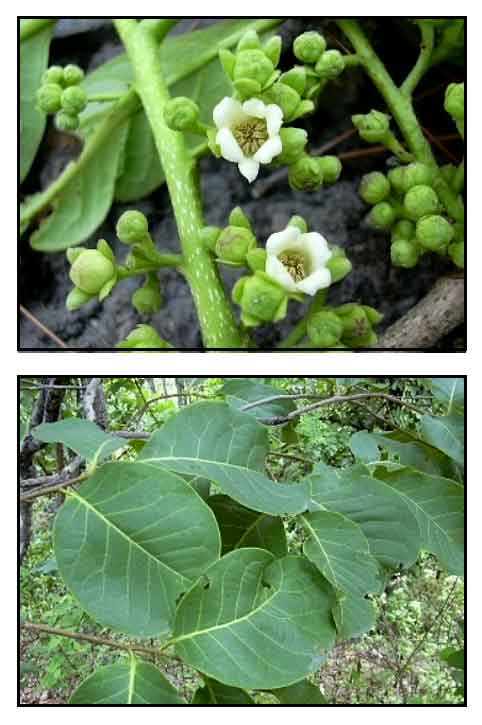 Gen info Gen info
- Diospyros is a genus of over 700 species of deciduous and evergreen trees and shrubs. The majority are native to the tropics. Some are valued for the hard, dark, and heavy timber; others valued for fruits; some used as ornamentals.
Botany
Diospyros ehretioides is a deciduous tree with a spreading crown, growing to a height of 16 meters, with a trunk up to 150 centimeters. Petioled are about 1 centimeter. Leaf blade is oblong-elliptic to elliptic.8 to 20 by6.5 to 9 centimeters, leathery, abaxially pubescent and denser in the middle, adaxially pubescent, glabrescent except for hairs along th midrib, base broadly cuneate to rounded; apex acute to rounded, lateral veins 6 to 10 per side, reticulate veinlets lax, slender, and raised on both surfaces Male flowers are in 3-flowered cymes, usually on current year's branchlets, small; calyx brownish villose, lobes 4; corolla about twice as long as the calyx.. Female flowers in pedunculate cymes, pedicels much shorter than peduncle, often only one forming fruit.. Fruiting calyx deeply divided, 1.5 to 1.8 centimeters in diameter, lobes some strongly reflexed, about 7 by 6 millimeters, often unequal, pubescent. Fruits are globose berries, up to 3.5 centimeters in diameter. Seeds are compressed, oblong, about 1.5 centimeters, endosperm ruminate. (9)
Distribution
- Introduced.
- An understorey tree in dense to open forests or slopes
- Native to Cambodia, Hainan, Myanmar, Thailand.
Constituents
- Study of dried fruits isolated deoxypreussomerin derivatives, palmarumycins JC1 (1) and JC2 (2), and two dimeric naphthoquinones, isodiospyrin (3) and its new derivative isodiosprol A (4). (see study below) (2)
- Study of stems isolated a new a new (naphthalenyl) methyl acetate, (1,4,5-trimethoxynaphthalen-2-yl)methyl acetate (1) and (±)-4,5-dihydroxy-2-methyltetralone (2) were isolated together with five lupane triterpenes (3–7), naphthoquinone derivatives (8–13), coumarins (14 and 15) and a vanillic acid (16). (see study below) (3)
- Preliminary phytochemical screening of air-dried stem bark yielded flavonoids, terpenoids, steroids, glycosides, reducing sugars, lipophilics, polyphenols, tannins, and phenolic compounds. An isolated compound (1) was identified as lupeol. (4)
- Study of water extract and ethyl acetate extract for total phenolic content yielded 34.67 and 375.11 mg GAE
/g extract. (see study below) (12)
Properties
- Studies have suggested antimalarial, antimycobacterial, cytotoxic, antifungal, xanthine oxidase inhibitory, radical scavenging, anti-inflammatory properties.
Parts used
Fruits and stems.
Uses
Folkloric
- No reported medicinal use in the Philippines.
- In Thailand, the plant is a component in a polyherbal formulation (macerated mixture of D. ehretioides, Memecyclon scutellatum, and Rothmannia wittii) for asthma and alimentary bleeding and inflammation.
- In Thailand, ground parts of D. ehretioides and Cassia siamea boiled and drunk for pharyngitis with bleeding in the throat. Macerated plant parts in water of D. ehretioides, M. scutellatum, and R. wittii taken orally for worm infection. (5)
-
Used by women during pregnancy, birth, and puerperium; also for respiratory problems. Stems are boiled and eaten to treat cough and vaginal discharge. (11)
Others
- Wood: Wood is moderately hard, even-grained, dark gray, with darker streaks, sometimes handsomely mottled. Used for house posts. (6)
- Fish poison: In Thailand, fruits used for fish poisoning (Utsunomiya et al, 1998).
- Gum: Plant yield a good quality gum (Jayaraman, 1996).
Studies
• Bioactive Deoxypreussomerins / Antimalarial / Antimycobacterial / Antifungal / Cytotoxic / Dried Fruits: Study of dried fruits isolated deoxypreussomerin derivatives, palmarumycins JC1 (1) and JC2 (2), and two dimeric naphthoquinones, isodiospyrin (3) and its new derivative isodiosprol A (4). The palmarumycins were not found in fresh fruit extracts, which suggests the palmarumycins JC1 and LC2 were more likely fungal metabolites, i.e., endophytes or epiphytes. JC2 exhibited antimalarial, antifungal, antimycobacterial, and cytotoxic activities. Isodiospyrol A (4) exhibited antimalarial and antimycobacterial activities. Compound 4 exhibited cytotoxicity against BC cells but not towards KB and Vero cell lines. (2)
• Cytotoxicity Against Cancer Cell Lines / Stems: Study of stems isolated a new a new (naphthalenyl) methyl acetate, (1,4,5-trimethoxynaphthalen-2-yl)methyl acetate (1) and (±)-4,5-dihydroxy-2-methyltetralone (2) were isolated together with five lupane triterpenes (3–7), naphthoquinone derivatives (8–13), coumarins (14 and 15) and a vanillic acid (16). Compounds 1 and 2 showed significant cytotoxicity against three cancer cell lines, HeLa, HCT116, and MCF-7 with IC50s in the range of 5.05-15.90 µg/mL, while compound 16 showed cytotoxicity against HeLa and HCT116 cells lines but no toxicity to Vero cells. (3)
• Ya-Mor-Noi (YMN) / Anti-Inflammatory / Post-Partum Treatment: Ya-Mor-Noi (YMN) is a Thai polyherbal remedy used for post-partum patients to reduce inflammation and rehabilitate them. Study evaluated the biological activities of YMN relating to postpartum conditions, including anti-inflammatory and wound healing activities. The seven herbal constituents of YMN are rhizome of Smilax corbularia, stem of Caesalpinia sappan, Goniothalamus laoticus, Polyalthia suberosa, Glycosmis pentaphylla, Croton persimilis, and Diospyros ehretioides. Ethanolic extracts of YMN showed inhibition of nitric production. The extract decoction showed significant wound healing compared to control. HPLC analysis revealed two main compounds: Brazilin and Astilbin. (10)
• Xanthine Oxidase Inhibitory / Radical Scavenging Activity: Study of water and ethyl acetate extracts of D. ehretioides showed xanthine oxidase inhibitory activity of 21.65% and 64.07%, respectively. Antioxidant activity by DPPH radical scavenging assay showed IC50s of 93.54 and 26.83 µg/mL for water extract and ethyl acetate extract, respectively. (see constituents above) (12)
Availability
- Wild-crafted.
|

![]()



 Gen info
Gen info